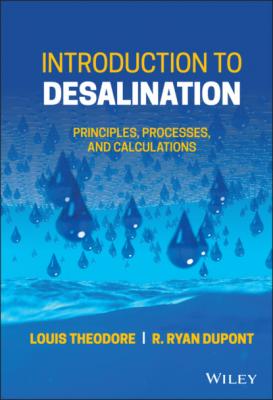Introduction to Desalination. Louis Theodore
Чтение книги онлайн.
Читать онлайн книгу Introduction to Desalination - Louis Theodore страница 35

3.9.3 Illustrative Example 3
Given the following data for liquid methanol, convert the heat capacity, thermal conductivity, and viscosity from SI units to English units:
Solution. Convert the heat capacity of methanol from units of cal/(g-°C) to corresponding English units of Btu/ ( lb-°F ) :
Note that 1.0 Btu/ ( lb-°F ) is equivalent to 1.0 cal/(g-°C). This also applies on a mole basis, i.e. 1 Btu/ ( lbmol-°F ) = 1 cal/ ( gmol-°C ) . The usual notation for heat capacity is Cp . In this book, Cp represents the heat capacity on a mole basis, while cp indicates heat capacity on a mass basis.
Convert the thermal conductivity of methanol from units of cal/(m-s-°C) to corresponding English units of Btu/ ( ft-hr-°F ) :
The usual notation for thermal conductivity is k.
C e to lb/(ft-s):
The notation for viscosity is typically µ. The kinematic viscosity, v, is defined by the ratio of viscosity to density, i.e. v = µ / ρ with units of length2/time. Finally, note that the above physical properties are strong functions of the temperature but weak functions of the pressure. Interestingly, the viscosity of a gas increases with increasing temperature, while the viscosity of a liquid decreases with an increase in temperature. These properties will be revisited in Chapter 04.
3.9.4 Illustrative Example 4
Consider the manufacture of ammonia from natural gas, which can be considered to be pure methane. In the first stage of the process, natural gas is partially oxidized in the presence of steam to produce a synthesis gas containing hydrogen, nitrogen, and carbon dioxide. The carbon dioxide is removed. The remaining mixture of hydrogen and nitrogen is reacted over a catalyst at high pressure to form ammonia. The two reactions for the process, neglecting side reactions and impurities, are as follows:
Sketch a flow diagram for this process.
Solution. See Figure 3.3 for a simplified process flow diagram for this ammonia manufacturing process.
Figure 3.3 Simplified process flow diagram for Illustrative Example 4.
3.9.5 Illustrative Example 5
All measurements and calculations are subject to two broad classes of errors: determinate and indeterminate. Any error that is discovered and allowed for in magnitude and sign in the form of a correction allowing for its effect is a “determinate error.” All errors that either cannot be or are not properly allowed for in magnitude and in sign are known as “indeterminate errors.” A particularly important class of indeterminate errors is that of accidental errors. Qualitatively discuss these two error types.
Solution. Determinate errors are systematic errors that can be discovered and corrected. Determinate errors include instrument errors, i.e. calibration errors, power fluctuations, method errors, i.e. sampling problems, inconsistent recovery, and personal errors, i.e. errors that occur when measurements require judgment, color interpretation, etc. Determinate errors can be corrected via proper instrument calibration, method development, or training. To illustrate the nature of indeterminate errors, consider the very simple and direct measurement of temperature. Suppose that several independent readings are made and that the temperature varies by 0.1°F. When the results of the different readings are compared, it may be found that even though they have been performed very carefully, they may differ from each other by several tenths of a degree. Experience has shown that such deviations are inevitable in all measurements and that they result from small unavoidable random errors of observation due to the sensitivity of measuring instruments and the keenness of the sense of perception. Such errors are due to the combined effect of a large number of undetermined causes and they can be defined as accidental or indeterminate errors (Prochaska and Theodore 2018; Theodore and Behan 2018).
3.10 Problems
1 The suspended particulate concentration in a brackish water source has been determined to be 27.6 mg/L. Convert this value to units of µg/L, g/L, lb/ft3, and lb/gal.
2 As part of a plant’s proposed desalination process cold seawater is mixed with recycled water from a dehumidifier (D), and the mixture then passes through a waste heat boiler (W), which uses air (A) as the heat transfer medium. The hot air and water mixture then pass through a humidifier (H), in which humid air is generated and then passed through the dehumidifier (D) and condensed to form potable water. Prepare a simplified process flow diagram for